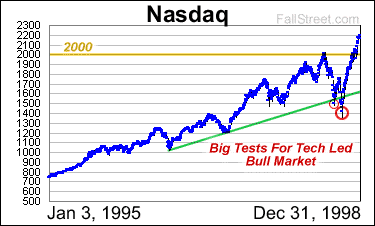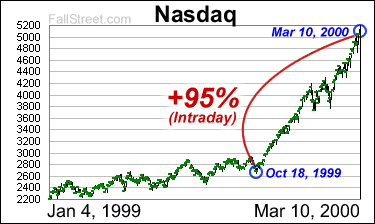September 19, 2003
Unpredictability in a Momentum Mad Marketplace
The Dow is at a 15-month high, and the Nasdaq is above 1,900 (an 18-month high). Lipper estimates that $26 billion was added to equity mutual funds in August, while a record $15.3 billion was siphoned out of bond funds during the same month. Trimtabs estimates that up to $30 billion will funnel into equity funds this month (which would be the highest inflow in more than a year).
In short, potentially over optimistic readings in investor sentiment, stretched valuations, and what will likely be a short lived economic recovery has meant little in recent monhts -- money is chasing stocks and prices are rising.
How Stock Market Momentum Was Created Yesterday
On July 16, 1998 the Nasdaq closed above 2,000 for the first time ever, and for a brief moment – as the Nasdaq crashed lower by more than 600 points – 2,000 appeared to be the bull market’s peak. However, as the Fed cut interests rates three times in quick succession to combat the Asian crisis (Sept, Oct, Nov 98), capital began to funnel into the United States. By the end of 1998 the Nasdaq was back above 2000.
 |
In 1999, once it became clear that the Asian crisis was not turning into a full blown financial contagion, the Fed took back the three cuts it handed to the markets in 1998. Oblivious to the adage ‘don’t fight the Fed’, investor’s pushed stocks up strongly leading in Y2K. When the Y2K bug threat turned out to be a bust tech stocks bolted higher still -- surpassing 5,000 before the real ‘peak’ was hit.
 |
The stock markets sustained momentum in the late 1990s because, for lack of a better term, upwards momentum ‘Fed’ upwards momentum. To be sure, as stock prices escalated this helped create favorable liquidity conditions for further price increases; sidelined observers that knew nothing about stocks wanted to acquire the day trading riches made by their friends/co-workers, and fund managers that voiced valuation concerns (as would be clients threw money at them) were erased from existence.
Needless to say, gambling on momentum based stocks was the only game in town in the late 1990s. If you invested in bonds or looked for dividend yields in utilities you were mocked by your peers, if you bought gold thinking it was cheap below $300 an ounce you were ignored or laughed at, and if you dare shorted stocks you were crushed. Yes, partly due to economic recession, 9/11, and Enron type fiascos/meltdowns the stock markets have been unable to sustain upside momentum since early 2000. Regardless, the late 1990s – for many years not months – stocks were in a momentum mania.
How Stock Market Momentum Was Created Today
Despite what can be called a suspect improvement in the fundamentals – the U.S. economy is ‘recovering’ without creating jobs and corporate profits are ‘improving’ without creating strong revenue growth – the markets have spent most of the year rallying because of what tomorrow may bring. The story goes that the Fed/government engineered economic expansion ensures that stock prices will continue to rally.
Recap: The 2003 Momentum Story:
* The Fed, for the first time in history, warns of deflationary pressures and cuts interest rates again. As bonds soar (yields crash lower), stocks also soar; equity investors believe that lower interest rates will be spark economic activity, corporate profits, and a resurgence in capital spending. The Fed promises to keep interest rates low and opens up the money flood gates.
* As President Bush enacts another tax cut package (dividend tax cuts being the center piece), companies scuttle to declare/boost dividends. Thanks to slumping bond yields, dividend paying stocks look more attractive (oddly enough, the near dividendless Nasdaq leads the markets). As tax rebates arrive in the mail back-to-school sales show improvement
Obviously there are other momentum considerations – including a successful end (in the market’s opinion) to the Iraq war, and the non-blow up of Freddie/Fannie following a spike in interest rates. However, beyond the Greenspan and Bush events – which if not helping the economy enough today supposedly bode well for tomorrow – the earnings situation has not been that much of surprise. In fact, manipulated 3Q03 EPS estimates, which currently call for a +14.9% increase year-over-year on the S&P 500, hit a high estimate of 16.6% on Jan 1 2003 and a low estimate of 12.7% on July 1, 2003, and 4Q03 EPS estimates have been at roughly +21% all year. In short, there has not been much wiggle in the EPS estimates this year, yet the Nasdaq has rallied 50% from its March bottom because Greenspan/Bush have helped foster a momentum mindstate back into the marketplace.
The Spin & Chase Market
When the Nasdaq was plunging in the summer of 1998 no one was predicting Nasdaq 5,000. Conversely, when the Nasdaq was soaring in March 2000 few people dared forecast Nasdaq 1000. Point being, a momentum based marketplace is not fueled by rising prices alone, but by the near universal perception that prices will continue going in the direction of least resistance forever. ‘Forever’ may not be the best word to describe momentum – then again, as the S&P 500 rallies most Wall Street analysts continually raise their forecasts (as if a rising stock market itself must mean that more gains are ahead).
Lipper estimates that $175 billion has been yanked from money market funds this year already (or nearly four times the total for all of last year).
To reiterate, the liquidity trend – into stocks and out of everything else – has, and continues to favorable for stocks. This doesn’t mean that stocks are a good, safe investment, but it does mean that more gamblers are chasing performance (which could suggest that they will continue to do so).
In sum, forecasting what the markets may do when stocks are being tossed around by little more than momentum and hopes for tomorrow is impossible to do. If a company beats the Street’s EPS estimate it rallies irregardless of quality of earnings and valuation considerations, if Merrill reinstates Citigroup with a buy rating its stock surges by nearly 4% (yesterday), and regardless of whether or not economic reports are better or worse than expected the markets spin the report in a positive light. For example, a jump in consumer prices would simply mean that deflation is dead while a decline in consumer prices means that interest rates will remain low forever…you don’t win in this market by thinking about things, but by spinning any news in a positive light and buying.
When Will The Momentum Die?
The better question might be when will an investment alternative for the masses arrive? To be sure, unless investor’s chasing performance today begin to chase something else tomorrow (perhaps bonds after the next yield spike?), fund managers have the ability to put capital to work in stocks. Incidentally, as was the case in the 1990s, if fund managers elect not to put money to work in equities they won’t be managers for long (or at least this is the current, growing perception after 7-months of inflows into equities).
That said, one of the speculations to be made is that when the dollar slides this will stall stocks. However, one has to wonder if this will really be the case. After all, remember that the dollar’s slide earlier this year was met with investor jubilation (corporate profits will benefit from a slumping dollar!).
Accordingly, the real speculation to be made is not that the dollar will not simply slide, but collapse. This nightmare scenario (which also conjures up a spike in U.S. interest rates) is one of the universal negatives stock market bears are chattering about. Why? Because a collapse in the dollar would mean that the Greenspan/Bush engineered recovery has failed, and that the momentum gambler’s have no rosy tomorrows to look forward to.
Unfortunately, the near term direction of the dollar is even more unpredictable than the near term direction of the stock markets. However, longer term - thanks to burgeoning twin deficits, stretched consumers, and an overcapcitized economy - the dollars slide is as predictable as the Nasdaq’s fall was in 2000.
The lesson being -- one which the mad 1998-2000 tech led momentum mania taught -- is that the Nasdaq’s fall, while predictable, was certainly not timeable.
a